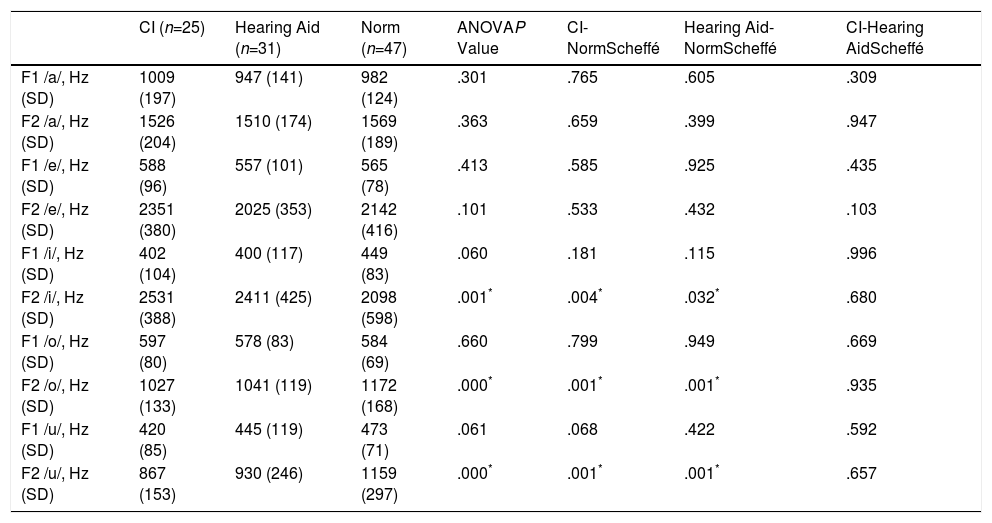Inadequate auditory feedback in prelingually deaf children alters the articulation of consonants and vowels.
The purpose of this investigation was to compare vowel production in Spanish-speaking deaf children with cochlear implantation, and with hearing-aids with normal-hearing children by means of acoustic analysis of formant frequencies and vowel space.
MethodsA total of 56 prelingually deaf children (25 with cochlear implants and 31 wearing hearing-aids) and 47 normal-hearing children participated. The first 2 formants (F1 and F2) of the five Spanish vowels were measured using Praat software. One-way analysis of variance (ANOVA) and post hoc Scheffé test were applied to analyze the differences between the 3 groups. The surface area of the vowel space was also calculated.
ResultsThe mean value of F1 in all vowels was not significantly different between the 3 groups. For vowels /i/, /o/ and /u/, the mean value of F2 was significantly different between the 2 groups of deaf children and their normal-hearing peers.
ConclusionBoth prelingually hearing-impaired groups tended toward subtle deviations in the articulation of vowels that could be analyzed using an objective acoustic analysis program.
La inadecuada retroalimentación auditiva en los niños con hipoacusia prelocutiva altera la articulación de consonantes y vocales.
El propósito de esta investigación es comparar la producción de vocales en niños hipoacúsicos hispanohablantes con implante coclear o adaptación audioprotésica con niños normooyentes por medio del análisis acústico de las frecuencias formánticas y el espacio vocal.
MétodoUn total de 56 niños con hipoacusia prelocutiva (25 con implante coclear y 31 con audífonos) y 47 niños normooyentes participaron en el estudio. Los 2 primeros formantes (F1 y F2) de las 5 vocales del idioma español se midieron utilizando el programa Praat. Para analizar las diferencias entre los 3 grupos se aplicó el método ANOVA de análisis de la varianza y el test de Scheffé. También se calculó el área del espacio vocal.
ResultadosEl valor medio del F1 en todas las vocales no mostró diferencias significativas en los 3 grupos de niños. Para las vocales /i/, /o/ y /u/ el valor medio del F2 fue significativamente diferente entre los 2 grupos de niños hipoacúsicos y el grupo de niños normooyentes.
ConclusiónAmbos grupos de niños con hipoacusia prelocutiva tienden a presentar sutiles desviaciones en la articulación de las vocales que pueden ser analizadas mediante un programa de análisis acústico.











